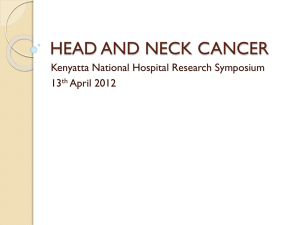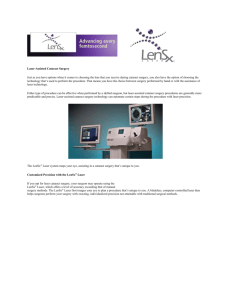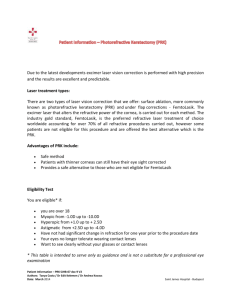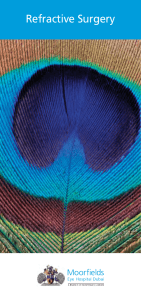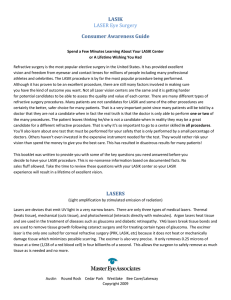Patient Information – FemtoLasik
advertisement
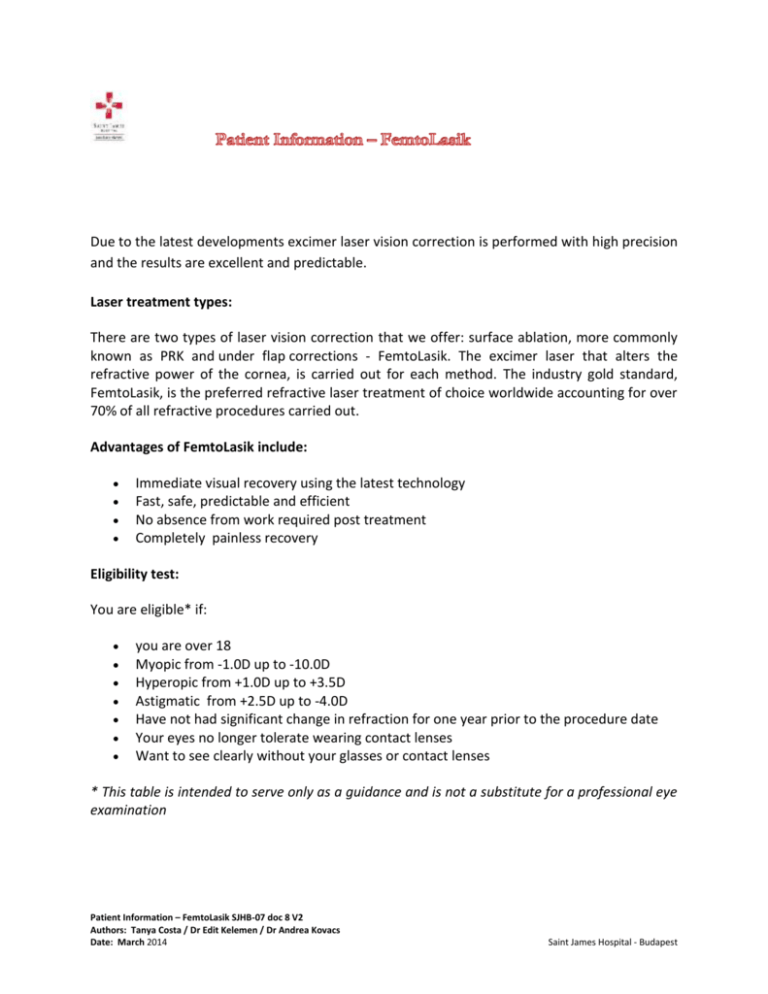
Due to the latest developments excimer laser vision correction is performed with high precision and the results are excellent and predictable. Laser treatment types: There are two types of laser vision correction that we offer: surface ablation, more commonly known as PRK and under flap corrections - FemtoLasik. The excimer laser that alters the refractive power of the cornea, is carried out for each method. The industry gold standard, FemtoLasik, is the preferred refractive laser treatment of choice worldwide accounting for over 70% of all refractive procedures carried out. Advantages of FemtoLasik include: Immediate visual recovery using the latest technology Fast, safe, predictable and efficient No absence from work required post treatment Completely painless recovery Eligibility test: You are eligible* if: you are over 18 Myopic from -1.0D up to -10.0D Hyperopic from +1.0D up to +3.5D Astigmatic from +2.5D up to -4.0D Have not had significant change in refraction for one year prior to the procedure date Your eyes no longer tolerate wearing contact lenses Want to see clearly without your glasses or contact lenses * This table is intended to serve only as a guidance and is not a substitute for a professional eye examination Patient Information – FemtoLasik SJHB-07 doc 8 V2 Authors: Tanya Costa / Dr Edit Kelemen / Dr Andrea Kovacs Date: March 2014 Saint James Hospital - Budapest Contraindications for laser treatment: Diabetes Autoimmune disease Wound recovery problems, keloid susceptibility Amblyopia, lazy eye Cataract/Glaucoma Pregnancy planned within six months Nursing mothers Keratoconus (irregular shaped cornea) Previous Herpes infection in the eye Severe dry eye syndrome Wearing reading-glasses only FemtoLasik – The Procedure You may be given a mild sedative tablet before surgery, a few anesthetic eye drops will be applied and the eyelids and area around the eye will be cleansed with an antiseptic solution. The surgery is completely painless. You may just feel some slight pressure on the eye while creating the flap and will be able to hear the sound of the laser as the treatment is in progress (few seconds). The surgery consists of two steps: 1. The patient lies comfortably on the laser bed. First, a flap is created using the femtosecond laser where millions of air bubbles are inserted in a specifically programmed dept. This flap is lifted and excimer laser is performed to reshape the curvature of the cornea. 2. Flap is replaced and vision improves immediately, however on the day of surgery you might experience some blurred vision. Most patients are usually able to see clearly as from the very next morning. No Pain is expected after surgery. After the procedure it is required to apply the prescribed eye drops, which are usually necessary for about a month. The day after surgery you will be seen again by the doctor and a week later as well. A further check-up is recommended within six months. It is advisable to wear sunglasses with UV protection for two or three months, when out in the sun. Solarium is not allowed. What to prepare before the surgery: Patient Information – FemtoLasik SJHB-07 doc 8 V2 Authors: Tanya Costa / Dr Edit Kelemen / Dr Andrea Kovacs Date: March 2014 Saint James Hospital - Budapest Do not wear any eye make-up Do not put any face or eye cream Do not put any perfumes or aftershave Have someone to accompany you What to do after the surgery: Protect the eye from water for 1 month while showering Do not rub your eye for 4 weeks Do not use eye make-up for 1 week, and do not use cream around your eye area for 1 week Do not swim, use sauna for 4 weeks After 1 week you are allowed to run, ride a bike, do aerobics, but wear sunglasses outdoors Avoid strenuous contact sports for 8 weeks Avoid solarium for 3 months (even with protective glasses) Use the medication as advised by the doctors Risks and Complications Like any other surgery, there may be risks and complications associated with this procedure. We always do our utmost to ensure that no complications arise and from past studies, we can say that FemtoLasik is considered as a safe and effective procedure. Dry eyes Dry eye is a common side effect in post- operative stage. For this reason, it is recommended that lubricating eye drops are applied to the operated eyes for a three- to six-month period. Most patients report, however, that they no longer need these eye drops for more than a month or two after surgery. Very few patients will need to put these drops for a longer period of time. Decreased night vision Risk of decreased night vision is extremely small and nowadays it is rarely documented to advancement in technology. Over or Under correction Over or under correction means that the final outcome will be slightly on the plus or minus side, which usually evens out with time. Sensitivity to light There might be an initial sensitivity to light that usually resolves within a few hours. Protrusion of the cornea (keratoconus) Due to the current technology, the risk is, as a consequence, practically non-existent. The more Patient Information – FemtoLasik SJHB-07 doc 8 V2 Authors: Tanya Costa / Dr Edit Kelemen / Dr Andrea Kovacs Date: March 2014 Saint James Hospital - Budapest precise preliminary examinations have also raised safety to a whole new level – and have already enabled the detection of keratoconus at an early stage. Retinal damage In the FemtoLasik method, eye pressure does not need to be raised to a high level. For this reason, damage to the retina is very rare indeed. Growing epithelium under the flap In the rare incidence that epithelium grows under the flap, this is removed. The incidence is less than 1 in a 1,000. Incomplete flap If for some reason the flap is made in an incomplete manner, a new one can be made immediately. Infections Infections are extremely rare and can be prevented by putting the eye drops as advised by our team and to perform correct hand hygiene. Patient Safety: Laser Technician present on site to assist during the procedure Patient identity checks according to WHO Safe Surgery Checklists Professional and well trained team with longstanding experience in refractive surgery Patient Information – FemtoLasik SJHB-07 doc 8 V2 Authors: Tanya Costa / Dr Edit Kelemen / Dr Andrea Kovacs Date: March 2014 Saint James Hospital - Budapest



